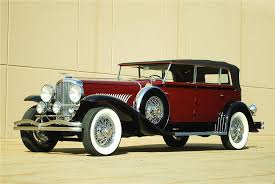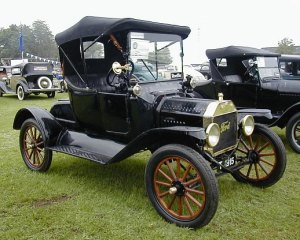A&E’s Top Ten Cars that Changed the Automotive Industry
In today’s world, the automobile is the most popular vehicle used for transportation. But a little over one hundred years ago, the only horse power used by the people had hooves and a mane. However, in 1908, Henry Ford’s business started the domino effect that built up the automotive industry throughout the twentieth century, enabling it to flourish for centuries to come. Thanks to these ten cars, the industry has grown into one that is massive and eclectic, consisting of 90+ makes, each with dozens of models to choose from.
#10 on the list is the 1886 Benz Motor Wagen, which was the first motorized vehicle. Carl Benz was an engineer with a vision that would ultimately rev the world. With a top speed of 7 mph and 9/10th of ONE horsepower, it couldn’t hold its own against its top competitor of that time, the horse, but it wouldn’t be long until Henry Ford made the horse and buggy a thing of the past.
#9 on the list is the 1929 Duesenburg. Along with introducing quality into the market, the Duesenburg set standards for luxury. With $20,000 price tag ($250,000 in today’s money), this car only appealed the rich upper-class, so that explains why only 481 were manufactured in total. The company dissolved in 1937 from the effects of the Great Depression but its legacy for producing luxurious, high-quality vehicles created a lasting impact in the car world.
#8 on the list is the 1955 Ford Thunderbird. This car attracted younger generations to the automotive industry. With its distinctive and ingenious style, it was expected to cause customers to flock to the nearest Ford dealerships, but it didn’t sell well, mainly because it was Ford’s response to the 1953 Corvette, which was so popular already. However, the failed experiment of the Thunderbird was the forefront of the successful Ford Mustang that would come only 9 years later.
#7 on the list is the 1953 Chevrolet Corvette. Ever since it was introduced at a car show in 1953, people couldn’t take their eyes off of it. Within 6 months, the Corvette went from a concept to a production car, a feat that cannot be accomplished today due to vigorous regulation tests. To Chevrolet’s surprise, only 300 sold within the first year, so they went back to the drawing board and added a fuel injection to the V8 engine, and in 1957, the Corvette was officially America’s sports car.
#6 on the list is the 1963 Jeep Wagoneer, which was the precursor to the SUV. As a status symbol of the 60s, the Wagoneer was practical for all kinds of uses, “from camping to Sunday church,” people drove them everywhere. Its durability and efficiency first benefitted combat in WWII, laying the foundation for its mass production in the future. Being the 1st 4 by 4 equipped with an automatic transmission, it also appealed to female consumers, practically doubling sales.
#5 on the list is the 1964 (and 1/2) Ford Mustang, which ultimately paved the way for muscle cars. After failing to sell Thunderbirds in the numbers they had projected in 1955, Ford came up with the Mustang, addressing all of the reasons why consumers weren’t dazzled by the Thunderbird. Nicknamed “the poor man’s Thunderbird,” the Mustang combined economy with pizzazz. It shattered the norm by defying the usual “small, medium, or large” car formula. A million were sold within the first year and a half alone. As a result of its popularity, it created three absolute necessities for muscle cars: a great looking exterior, a great looking interior to reinforce the standard set by the exterior, and a high power of performance. The Mustang revolutionized the industry for muscle cars by raising the standard for burning rubber with style and economic appeal.
#4 on the list is the 1983 Chrysler Minivan. In terms of physical appearance, this car wasn’t anything to write home about, but Chrysler wasn’t trying to design a car that would appeal to both soccer moms and teenage boys. Amidst the baby-boom of the 80s, the Minivan was an absolute necessity for big families. It ran the Station Wagon right off the road with its utility and fuel efficiency. Within the first year, 200,000 Minivans were sold. It made a lasting impression on the world and remains a popular car of choice for families today, and thankfully, manufacturers have found ways to make the exterior more attractive, eliminating the requirement to sacrifice appearance for utility.
#3 on the list is the 1966 Toyota Corona, which opened up the market for Japanese cars in America. In 1957, Toyota introduced their first American-imported car, but it couldn’t even reach 60 mph, so their dreams of American importation went up in flames. But less than 10 years later, Toyota introduced the fuel-efficient, domestic Corona. 4,000 were sold within the first 4 months, outselling all of the other Toyotas in the U.S. over the last 6 years combined. It was a lifesaver when the gas crisis of 1973 hit. Ever since the success of the Corona, the Japanese import market has been prominent in the U.S.
#2 on the list is the 1949 Volkswagen Beetle. This cute, fun, aptly named car introduced a whole new look to the automotive industry. With only 2 of the cars sold in the U.S. within its 1st year in the market, probably due to strong sentiment against the Germans during WWII, it wasn’t expected to survive. But clever advertising ultimately saved the Beetle from extinction in the American market, creating slogans like “think small” that were simple, sensible, and economical. It went on to outsell the Model T in numbers with its universal appeal.
#1 on the list is the 1908 Ford Model T. Henry Ford’s vision revolutionized the entire world. He looked at the 1886 Benz Motor Wagen and saw potential. He wanted to produce an affordable automobile that could exceed 7 mph (top speed: 45 mph). Ford also realized that mass production was more cost-efficient. And so the assembly line was born, changing production forever. In the first year, 14,000 were sold, and after 10 years, 3,000,000 were rolling off the assembly line. Henry Ford’s Model T impacted the world beyond the automotive industry because it put the world on wheels.
Even though this documentary was made in 1990, I believe that A&E’s Top Ten List of Cars that Changed the Automotive Industry remains airtight, even after 25 years. The list takes into account the economic practicality of each car as well as their individual characteristics that caused them to have the great impact that they had in the world of cars and the world itself.
My personal favorite of the 10 is the 1964 and 1/2 Ford Mustang for reasons that just don’t have to be explained 🙂









